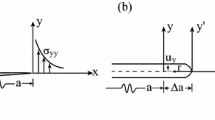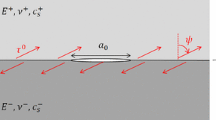Abstract
The Virtual Crack Closure Technique was first presented in 1977 for cracks in linear elastic, homogeneous and isotropic material. It makes use of the Irwin crack closure integral to obtain values of the modes I, II and III energy release rates from finite element data. It can easily be extended to anisotropic material. In addition, it was extended to cracks along an interface between two dissimilar linear elastic, homogeneous and isotropic materials. In that case, the energy release rates were seen to depend upon the size of the virtual crack extension usually taken as the size of the element adjacent to the crack tip. Some attempts have been made to remove this dependence. Nevertheless, in most cases, the accuracy of both the energy release rates and stress intensity factors was not consistently good. In this note, the dependence of the energy release rates on the size of the virtual crack extension for interface cracks is analytically accounted for so that the stress intensity factors may be accurately obtained when fine finite element meshes are used, together with a virtual crack extension consisting of more than one element.





Similar content being viewed by others
References
Agrawal A, Karlsson AM (2006) Obtaining mode mixity for a bimaterial interface crack using the virtual crack closure technique. Int J Fract 141:75–98
Banks-Sills L (2015) Interface fracture mechanics: theory and experiment. Int J Fract 191:131–146
Beuth JL (1996) Separation of crack extension modes in orthotropic delamination models. Int J Fract 77:305–321
Bjerkén C, Persson C (2001) A numerical method for calculating stress intensity factors for interface cracks in bimaterials. Eng Fract Mech 68:235–246
Chen FHK, Shield RT (1977) Conservation laws in elasticity of the \(J\)-integral type. J Appl Math Phys 28:1–22
Chow WT, Atluri SN (1995) Finite element calculation of stress intensity factors for interfacial crack using virtual crack closure integral. Comput Mech 16:417–425
Dattaguru B, Venkatesha KS, Ramamurthy TS, Buchholz FG (1994) Finite element estimates of strain energy release rate components at the tip on an interface crack under mode I loading. Eng Fract Mech 49:451–463
Gradshteyn IS, Ryzhik IM (1965) Table of integrals, series and products. Translated by Jeffrey A. Academic Press, New York
Hemanth D, Shivakumar Aradhya KS, Rama Murthy TS, Govinda Raju N (2005) Strain energy release rates for an interface crack in orthotropic media—a finite element investigation. Eng Fract Mech 72:759–772
Irwin GR (1958) Fracture. In: Flugge S (ed) Encyclopedia of physics, vol 4. Springer, Berlin, pp 551–590
Krueger R (2004) Virtual crack closure technique: history, approach, and applications. Appl Mech Rev 57:109–143
Malyshev BM, Salganik RL (1965) The strength of adhesive joints using the theory of fracture. Int J Fract Mech 1:114–128
Mantic̆ V, París F (2004) Relation between SIF and ERR base measures of fracture mode mixity in interface cracks. Int J Fract 130:557–569
Maple 14.00 (2010) Maplesoft, Waterlook Maple Inc
Oneida EK, van der Meulen MCH, Ingraffea AR (2015) Methods for calculating \(G\), \(G_{I}\) and \(G_{\mathit{II}}\) to simulate crack growth in 2D, multiple-material structures. Eng Fract Mech 140:106–126
Raju IS (1987) Calculation of strain-energy release rates with higher order and singular finite elements. Eng Fract Mech 28:251–274
Raju IS, Crews JH Jr, Aminpour MA (1988) Conversgence of strain energy release rate components for edge-delaminated composite laminates. Eng Fract Mech 30:383–396
Rice JR, Sih GC (1965) Plane problems of cracks in dissimilar media. J Appl Mech 32:418–423
Rice JR (1988) Elastic fracture mechanics concepts for interfacial cracks. J Appl Mech 55:98–103
Rybicki EF, Kanninen MF (1977) A finite element calculation of stress intensity factors by a modified crack closure integral. Eng Fract Mech 9:931–938
Sun CT, Jih CJ (1987) On strain energy release rates for interfacial cracks in bi-material media. Eng Fract Mech 28:13–20
Sun CT, Qian W (1997) The use of finite extension strain energy release rates in fracture of interfacial cracks. Int J Solids Struct 34:2595–2609
Toya M (1992) On mode I and mode II energy release rates of an interface crack. Int J Fract 56:345–352
Acknowledgments
I would like to thank Rami Eliasi for his assistance with the finite element analyses.
Author information
Authors and Affiliations
Corresponding author
Rights and permissions
About this article
Cite this article
Banks-Sills, L., Farkash, E. A note on the Virtual Crack Closure Technique for a bimaterial interface crack. Int J Fract 201, 171–180 (2016). https://doi.org/10.1007/s10704-016-0120-z
Received:
Accepted:
Published:
Issue Date:
DOI: https://doi.org/10.1007/s10704-016-0120-z




